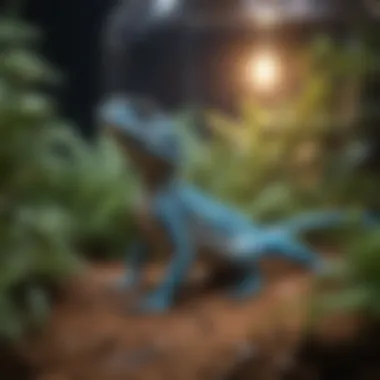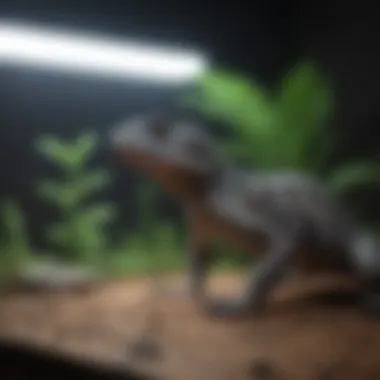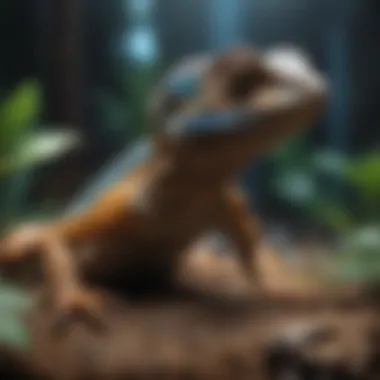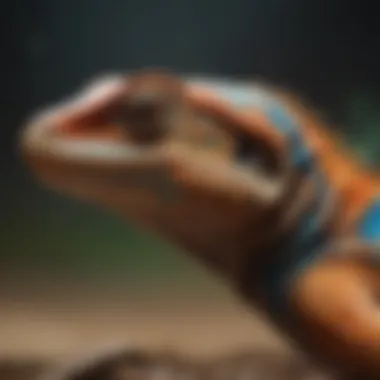The Essential Role of UV Lamps for Captive Lizards


Intro
Key Points Discussed
The article seeks to elucidate several essential points. Firstly, it dives into the specific light needs of various lizard species and how each species might respond to different wavelengths of UV light. Secondly, we will examine the types of UV lamps available on the market, their pros and cons, and their appropriate application in lizard care. Thirdly, setting up an optimal habitat becomes crucial, where the placement and distance of these lamps can vairely impact their effectiveness. Throughout the narrative, special attention will also be paid to the physiological benefits of proper UV exposure, and the potential risks accompanying inadequate lighting practices.
The discussion will also encompass the need for routine maintenance of these lamps and practical care tips that help maintain an ideal environment for a wide array of lizard species. Quite simply, having sufficient and appropriate UV light is a cornerstone of keeping pet lizards healthy and thriving in captivity.
Prolusion to UV Lighting for Lizards
The role of ultraviolet (UV) lighting is vital for lizards kept in captivity. This section aims to highlight the integral nature of UV exposure for lizard health and development. To sustain their well-being, it is critical for lizards to receive adequate UV light. Without it, lizards may face serious health issues, whilst proper provision of such light can enhance their quality of life.
Understanding UV lighting starts with acknowledging its significance. Correct lighting supports essential bodily functions in lizards, enabling them to metabolize calcium, synthesize vitamin D, and experience natural behaviors. Hence, for anyone dedicated to keeping these creatures healthy, comprehending the ins and outs of UV lighting is essential.
Understanding UV Light
The spectrum of light human beings utilize seldom includes the range known as ultraviolet light. UV light is divided into three bands: UV-A, UV-B, and UV-C. Each spectrum plays a distinct role and affects biological systems differently. UV-A contributes to the overall wellness of reptiles. It plays a role in stimulating their activity levels and is crucial for the behavior of most species.
UV-B is particularly significant. It enables the biosynthesis of vitamin D3 from provitamin D3 and has a direct impact on calcium absorption. A lack of exposure to UV-B can lead to increased susceptibility to metabolic bone disease.
Conversely, UV-C has limited use within reptile habitats. It can be harmful, primarily when used without care, hence it must always be controlled when administering any UV light.
Why Lizards Require UV Light
Lizards need UV light for multiple reasons directly linked to their health. Firstly, the synthesis of vitamin D is extremely important for maintaining their skeletal health. In captivity, lizards do not have access to natural sunlight; without the provision of sufficiently strong UV light, complex metabolic processes cannot work effectively. This lack of vitamin D leads to issues such as metabolic bone disease. As the bones weaken and become brittle, it results in other complications.
The need for UV lighting is compounded by lizard behavior. UV light affects their ability to thermoregulate as well. Lizards thrive under conditions replicating their native habitats; thus, appropriate light helps cue their circadian rhythms, which relates directly to overall behavioral health. Different species have varying needs in this regard, emphasizing the need for customized care in their habitat delivery.
Maintaining the right distance and the correct placement of UV lamps ensures that lizards experience the beneficial effects to the fullest. Likewise, recognizing these requirements culminates in expected long-term benefits, leading to healthier, happier lizards in captivity.
The Science Behind UV Radiation
Understanding the science behind UV radiation is critical for the care of captive lizards. This knowledge not only influences their health but also their overall quality of life. UV radiation encompasses several distinct types, each playing a unique role in the developmental needs of lizards. Moreover, recognizing the biological effects of UV light demonstrates why it is necessary to provide an adequate amount in a controlled setting.
Types of UV Radiation
UV-A
UV-A rays have a wavelength ranging from 320 to 400 nanometers. These rays are important because they contribute to lizard activity and behavior. Lizards exposed to UV-A often exhibit enhanced appetite and increased activity levels. One key characteristic of UV-A is its ability to penetrate deeper into the skin. This enables it to assist in several physiological processes. It can though, be less effective on its own in stimulating the production of vitamin D3 compared to UV-B rays. However, UV-A is still a beneficial aspect of lizard habitats, widely recognized for encouraging natural behaviors and improving mood.
UV-B
UV-B rays, with wavelengths from 280 to 320 nanometers, are crucial for lizards when it comes to synthesizing vitamin D3. This type of radiation is often considered one of the most beneficial for lizards because of its direct role in enabling calcium absorption. Others key characteristic is that UV-B light cannot penetrate glass, making it imperative to use specific types of UV bulbs to ensure lizards receive sufficient exposure. Lamps designed with UV-B are popular in keeping lizards healthy and promoting metabolic functions.
UV-C
UV-C rays possess wavelengths between 100 and 280 nanometers. Unlike UV-A and UV-B, UV-C is largely harmful to living organisms including lizards. The main characteristic of UV-C is its germicidal properties; it can effectively kill bacteria and viruses, making it unsuitable for prolonged exposure to reptiles. While beneficial for sterilizing equipment or controlling specific pathogens, caregivers should exercise caution as UV-C exposure can lead to skin burns and other injuries.
Biological Effects of UV Light
Examining the biological effects of UV light reveals how integral they are to a lizard's well-being. Precise knowledge about vitamin D synthesis and the process of calcium absorption can shape how lizard owners provide the necessary UV exposure.
Vitamin Synthesis


Vitamin D synthesis occurs primarily when lizards expose their skin to the UV-B rays. This process is crucial for their growth and development. The key characteristic of this synthesis is enabling the transformation of 7-dehydrocholesterol in the skin into vitamin D3. This is beneficial as it regulates calcium levels within the body. However, excessive exposure to UV rays without appropriate balance can lead to hypervitaminosis D, making strict monitoring essential.
Calcium Absorption
Calcium absorption relies heavily on adequate levels of vitamin D3. When lizards synthesize enough vitamin D, it allows for the proper utilization of dietary calcium. This is particularly crucial for skeletal health. The unique feature of calcium absorption is its role in preventing metabolic bone diseases. Without sufficient calcium intake, reptiles may develop weakened bones causing a range of health issues and lethargy. Thus, ensuring optimal exposure to both UV-A and UV-B is vital for their well-being.
Important Note: Continuous exposure to appropriate UV lamps can mitigate deficiencies and foster better health in lizards.
Evolving Needs of Different Lizard Species
The variety of lizard species means their needs can differ significantly. This section aims to give insights into the specific requirements based on species, focusing on how their evolutionary backgrounds influence these needs. Understanding these factors is crucial for creating an optimized environment that promotes health and well-being for different lizard types.
Desert Lizards
Species Overview
Desert lizards thrive in arid environments. Species such as the Horned Lizard and the Sonoran Desert Tortoise exemplify the traits needed for survival in dry conditions. Their adaptation is a crucial aspect when considering them as pets. These lizards possess unique scales which help reduce water loss. This characteristic ensures a healthy lifestyle in captivity if their habitat mimics desert environments adequately.
One significant quality of desert lizards is their calm demeanor. Ease of care and low handling stress tend to make them favorable for hobbyists. However, their requirements for UV exposure cannot be undervalued. A suitable UV light setup can improve their metabolism and stress levels greatly.
UV Requirements
Desert lizards have heightened UV needs. They rely heavily on UV-B for effective vitamin D synthesis. This is critical for calcium absorption and overall metabolic function. In captivity, it is essential to provide adequate UV-B radiation, which can often be overlooked.
The unique feature of these lizards is their ability to absorb UV rays for prolonged grmt periods during the day. This trait suggests that prolonged access to UV lighting throughout their habitat time must reflect natural day cycles. A deficiency could lead to significant health problems like metabolic bone disease. Providing proper UV sources should consider both light intensity and exposure duration.
Tropical Lizards
Species Overview
Tropical lizards present a different set of challenges and benefits. Species such as chameleons and anoles are well recognized for their vibrant colors and active behaviors. They prefer humid environments rich in plant life, explaining their behavioral features. The marrying of color and activity makes them attractive to enthusiasts looking for more visually interesting reptiles.
Tropical lizards also flourish with regular environmental humidity, as it reflects their native ecosystems. Opting for a tropical lizard can provide stimulating interactions when designing their habitat carefully. However, they can exhibit stress and aggression if not housed with suitable companions, making habitat harmony a priority for owners.
UV Requirements
Like their desert counterparts, tropical lizards also require UV light, but their needed intensity might differ. High levels of UV-A light are equally important alongside the UV-B spectrum. In many tropical environments, the sun is consistent, leading to more varied UV exposure. Captive lighting should mimic these conditions to encourage healthy defenses and behaviors.
Unique to tropical lizards is the moisture in their environment. This moisture affects how UV lights might impact their lizards' health, potentially leading to skin issues if they are not given proper shade and exposure limits. Creating a habitat that balances UV needs with humidity levels should be a priority for lizard guardians. Overexposure could intensify heat issues instead of offering beneficial light.
“Accurate assessment of a lizard’s UV requirements ensures its health remains optimal while reflecting natural behaviors.”
By understanding the specific needs based on evolutionary adaptations and specific traits, lizard owners can provide a better, healthier environment. This focus promotes not just survival but flourishing lizard companions.
Choosing the Right UV Lamp
Choosing an appropriate UV lamp is crucial for the well-being of lizards in captivity. Each type of lamp offers unique features and benefits that directly affect the health of these reptiles. The right lamp can restore a semblance of their natural environment and help lizards thrive. This section will address various types of UV lamps, along with critical factors to consider while making a decision.
Types of UV Lamps
Fluorescent Bulbs
Fluorescent bulbs are widely used among lizard owners. Their ability to emit both UV-A and UV-B light ensures a balanced spectrum suitable for many lizard species. A key characteristic of these bulbs is their efficiency. They can create optimal temperature and light conditions without excessive heat output. This feature makes them a favorite among hobbyists who want to avoid overheating their terrariums.


However, fluorescent bulbs have their drawbacks. The UV output diminishes over time, necessitating regular replacement to maintain effectiveness. It is also essential for owners to position the bulbs correctly within the enclosure. A significant bonus is that these lamps are usually more affordable and easier to find compared to some other types.
Mercury Vapor Bulbs
Mercury vapor bulbs generate a high level of UV radiation and also provide heat, thus fulfilling two requirements in one fixture. The most noted aspect here is their strong UV output that directly supports vitamin D synthesis and calcium absorption. A popular choice among those who maintain larger enclosures or species that have higher UV requirements, these bulbs offer an effective way to create ideal basking spots.
Nevertheless, mercury vapor bulbs can be a double-edged sword. They typically consume more power and can generate considerable heat. Adequate distance and proper placement are crucial to prevent overheating the lizard. Another downside is the cost; they can be more expensive than alternate lighting options.
LED UV Lights
LED UV lights are becoming increasingly popular for their long lifespan and energy efficiency. A notable benefit of these lights is their low heat output, reducing the risk of thermal burns for lizards. Those investing in LED UV lights can expect a brightness that rivals traditional bulbs without the added worries of overheating.
Conversely, the primary concern is that not all LED lights provide a full spectrum of UV radiation. Lidfs with lower wattage may fail to emit adequate UV-B rays necessary for certain lizard species. Proper research and careful selection are vital to ensure that the LED option chosen meets the specific lighting requirements of the lizards in your care.
Factors to Consider
When selecting a UV lamp, it is essential to evaluate several key elements.
Wattage
Wattage indicates the power that the lamp consumes, which can influence both light intensity and energy costs. Higher wattage can produce more intense light output, possibly ideal for larger enclosures hosting multiple lizards. Lizard keepers may choose lower wattage options for smaller setups or species with less demanding needs. Just be mindful that higher wattage could necessitate additional equipment like dimmers or heat shields to manage temperature.
Spectrum
The spectrum of light emitted by the lamp is vital for lizard health. A good UV lamp must emit both UV-A and UV-B spectra. UV-A supports overall activity, while UV-B helps synthesize vitamin D3 critical for calcium absorption. Choosing a lamp with a complete spectrum enables lizard owners to mimic daylight conditions and provide a balance of lighting requirements. Poor spectrum output can lead to health issues in lizards, highlighting this aspect's importance.
Lifespan
Lifespan affects both cost and planning for maintenance. It measures the duration a lamp will remain effective before needing replacement. Longer-lifespan light sources help avoid the frequency of replacements, allowing for more serene environmental management. However, some high-lifespan bulbs may come with a higher initial cost but prove financially practical over time due to reduced replacement needs.
In summary, selecting the correct UV lamp involves careful assessment of type, wattage, spectrum, and lifespan. Owners should choose lamps suited to their specific slice of the reptilian world, creating healthier captive environments filled with life.
Setting Up an Optimal Habitat
Setting up an optimal habitat is crucial for the well-being of lizards in captivity. Excelling in their environment enables lizards to exhibit natural behaviors, which is fundamental for their mental stimulation and physical health. Creating a suitable habitat includes understanding light placement, temperature gradients, and essential hides or shelters that promote comfort and safety.
Firstly, it's important to acknowledge that lizards have specific UV light needs that vary according to their species and geographical origins. This means their habitat must cater not just to their physical attributes but also to their biological requirements, especially concerning UV exposure.
A well-executed habitat setup not only meets the lizard's daily needs but can also prevent stress-related health issues. It allows them essential space quare to move around, bask in UV light, and thermoregulate effectively. A sophisticated knowledge on habitat configuration will improve the quality of life for these reptiles, leading to longer, healthier lives.
Placement of UV Lamps
The placement of UV lamps significantly influences their effectiveness. The first consideration is direction and height. It is important that the UV light is not obstructed by decorations or furnishings. Kiln-dried wood or upward-mounted branches are good options to optimize hindrance. The light should often be directed toward areas where the lizard will bask.
Common practices suggest the lamp should be mounted securely, so it excludes risk of falling. Ideally, it should take the focal point of the enclosure, ensuring the lizard can maneuver easily from shaded to exposed positions. Most setups benefit from strategic use of both UV and heat sources next to each other. This helps lizards find thermal gradients appropriate for their basking habits.
Distance from the Lizard
Taking account the distance from the UV lamp to the lizard is also a key aspect of effective lighting. The intensity of UV light reduces as the distance increases. Too far from the UV source may subject the lizards to inadequate UV exposure, undermining their essential physiological barrier. The recommended distance varies depending on lamp type and wattage.
Monitoring UV Exposure
Monitoring UV exposure is crucial for maintaining the health of lizards in captivity. Without the right levels of UV radiation, these reptiles may suffer from serious health issues. Regular assessment of UV output can help lizard owners ensure their pets thrive in a controlled environment.


Using UV Meters
A UV meter is an essential tool for any lizard owner. These devices measure the intensity and spectrum of UV light emitted by lamps. There are several advantages of using a UV meter:
- Precision: Accurate readings can pinpoint the level of UV light in the enclosure.
- Safety: Protects against overexposure, as too much UV-B can be harmful to lizards.
- Timeliness: Allows for regular checks, which could help decrease the risk of health problems.
Investing in a quality UV meter provides more than just data; it offers peace of mind regarding lizard health. Setting up a regular checking system can greatly enhance the husband's peace of mind.
Signs of UV Deficiency
Observing changes in a lizard’s behavior can be a clear indicator of UV deficiency. Symptoms may include:
- Metabolic issues: Poor diets can lead to deficiencies, showing vulnerabilities in overall health.
- Lethargy and weakness: Lack of energy may result from inadequate UV exposure necessary for vitamin D synthesis.
- Poor appetite: This can be a direct response to feeling unwell or struggling to absorb nutrients due to low UV levels.
It's vital to respond quickly to any signs of deficiency. Revising the lighting setup or lamp choice can often help remedy the situation before serious health problems develop.
Counting these signs can save lizard owners from long-term problems. Being proactive about UV monitoring leads to healthier lizards. It is better to maintain optimal UV levels than to face the consequences of neglecting this vital aspect of care.
Potential Risks of Inadequate UV Lighting
Inadequate UV lighting poses significant risks to the health of lizards in captivity. UV light is not just a luxury; it is a necessity for numerous physiological functions in reptiles. The absence of proper UV exposure can lead to serious health complications, thereby compromising the overall well-being of pet lizards. This section explores the potential health issues and long-term effects that inadequate UV lighting can create, particularly focusing on metabolic bone disease and general weakness and lethargy.
Health Issues Linked to UV Deficiency
Metabolic Bone Disease
Metabolic Bone Disease, often known as MBD, represents a crucial aspect of the health consequences of UV deficiency in lizards. This condition stems from a combination of insufficient vitamin D and calcium absorption. Lizards require UV-B for the synthesis of vitamin D, which is essential for calcium metabolism. Without this crucial lighting, lizards struggle to maintain strong bones, leading to severe deformities and health issues.
MBD is a primary concern for lizard owners. It often helps highlight the necessity of proper UV lighting systems. Lizards suffering from MBD may exhibit swollen limbs and a distorted shape. This disfigurement is alarming but often avoidable with appropriate UV exposure. Notably, metabolic bone disease not only leads to pain for the suffering animal but can also be a chronic issue that shortens the life expectancy of affected lizards.
Weakness and Lethargy
Weakness and lethargy is another notable consequence of inadequate UVama exposure. A lizard deprived of the necessary UV light becomes sluggish, reducing its energy to engage in normal activities like eating and basking. Without adequate energy, a lizard's immune system may also become compromised, increasing susceptibility to infections.
The futility of maintaining a vibrant lifestyle for a lizard invalidates the joyous experience of pet ownership. When lizards lack stimulation from adequate lighting, it includes behavioral changes that can lead to further stress. This lethargy not only affects the lizard’s immediate health but may also lead to long-term emotional issues. Providing proper lighting keeps the lizard's natural instincts alive and promotes its welfare.
Long-Term Effects of Poor Lighting
Poor UV lighting can have enduring implications beyond immediate health concerns. Over time, prolonged UV deprivation fosters a cascade of health issues that might not be visible at first. Bone deformities resulting from metabolic bone disease can take years to manifest, often leading to permanent damage or disability.
Moreover, inadequate exposure can lead to diminished health, which can complicate treatments for unrelated health conditions, further taxing the owner’s efforts and resources. The risk of chronic illness grows, along with heightened financial strains associated with veterinary care. Experts suggest that investing in proper UV lighting as part of the captive environment significantly reduces these long-term risks, maximizing the quality of life for lizards.
End
Lizard owners must understand the critical role of UV lamps in the health and vitality of their pets. The journal presents the idea that adequate UV lighting is not just beneficial but necessary for maintaining lizard well-being. Knowing the right type and dosage of UV light can lead to healthy and thriving lizards. Moreover, insufficient UV exposure leads to several medical issues which not only compromise the lizard's quality of life but also affect their long-term survival.
Inadequate UV lighting can cause stunted growth, poor calcium absorption, and immunosuppression, opening avenues for illness. By linking the biological impact of UV light directly to the metabolic health of lizards, this article pointed to an essential aspect often neglected by beginner owners. The risk of Metabolic Bone Disease due to low vitamin D levels is just one example that exemplifies this grief.
Furthermore, the importance of consistent monitoring through UV meters should not be overlooked. It allows owners to fine-tune their habitat for their lizards to create a balanced and nurturing environment.
Lastly, incorporating a checklist for best practices encourages active involvement in lizard care and highlights how preemptive strategies can avert future health complications.
Final Thoughts on UV Lighting
Recommendations for Lizard Owners
- Understand Your Species: Different lizard species have varied UV requirements.
- Select the Right Lamp: Choose lamps that emit the proper spectrum.
- Monitor UV Radiation: Use UV meters regularly to ensure adequate levels.
- Maintain Proper Distance: The distance between your UV lamp and the lizard should follow the manufacturer's guidelines.
By incorporating these recommendations, lizard owners can play an active role in maintaining not just the immediate health of their animals but also their long-term happiness. The objective is to replicate natural conditions in captivity as closely as possible.















